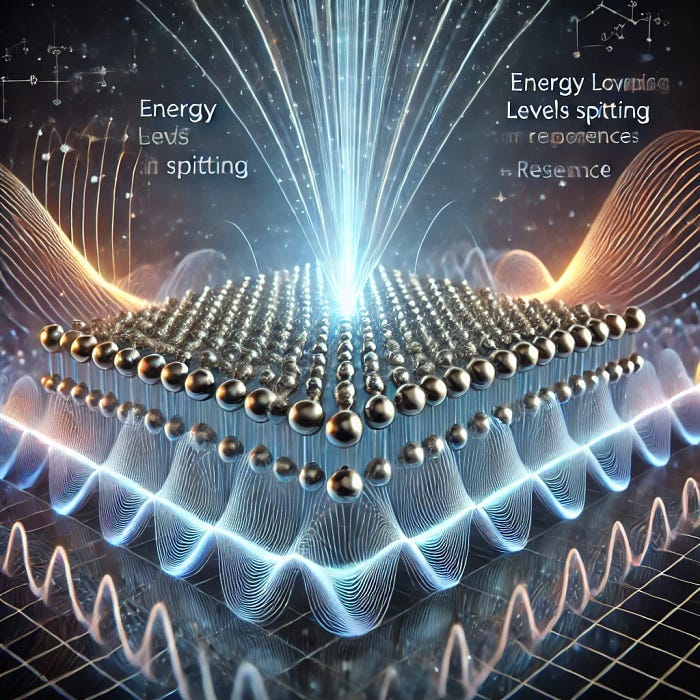Quantum Dots and the Theory of Magnetivity: Redefining the Role of Magnetic Fields in Quantum Mechanics
How nanoscale quantum dots provide a testing ground for the Theory of Magnetivity, revealing potential breakthroughs in quantum computing, secure communication, and data storage.
Exploring the Intersection of Quantum Nanostructures and Fundamental Forces

Quantum Dots
Quantum dots (QDs) are nanoscale semiconductor particles that exhibit unique electronic and optical properties due to their small size, typically only a few nanometers in diameter. These particles confine electrons in a very small space, which quantizes their energy levels and gives quantum dots properties similar to individual atoms. Because of their size-dependent behaviors, quantum dots can absorb and emit specific wavelengths of light, making them highly versatile for applications in fields like display technology, quantum computing, biological imaging, and secure communications.
How Quantum Dots Correlate with the Theory of Magnetivity
The Theory of Magnetivity, which posits that magnetic fields are fundamental forces that shape space-time, provides an intriguing framework for understanding the interactions between magnetic fields and quantum phenomena — especially as seen in structures like quantum dots. Here’s how quantum dots intersect with the Theory of Magnetivity:
Magnetic Field Influence on Quantum States
In quantum dots, the quantum confinement of electrons allows for precise control of energy states. According to Magnetivity, magnetic fields might play a more foundational role than traditionally thought in stabilizing or altering these states:
Spin States and Magnetic Control: Quantum dots often rely on electron spin states, which can be influenced by magnetic fields. This aligns with Magnetivity’s suggestion that magnetic forces might play a central role in quantum coherence and entanglement, potentially allowing magnetic fields to manipulate spin states more precisely.
Resonance and Field Tuning: By applying external magnetic fields to quantum dots, scientists can fine-tune the energy levels, effectively creating a “magnetic resonance” that affects electron behavior. This tuning process could allow for more controlled and dynamic quantum operations.
Magnetic Fields and Quantum Entanglement
The Theory of Magnetivity proposes that magnetic fields are essential in quantum mechanics, influencing phenomena like entanglement. In quantum dots:
Enhanced Entanglement Control: Magnetic fields can enhance or stabilize entangled states in quantum dots. This aligns with the Magnetivity concept that magnetic fields might be critical in supporting and maintaining entanglement, which is essential for secure quantum communication.
Quantum Communication and Storage: Quantum dots’ entangled states, influenced by magnetic fields, offer potential in quantum communication. For instance, Magnetivity’s view on magnetic fields could lead to better stability in quantum dots, reducing decoherence and enabling more reliable quantum data transmission and storage.
Advanced Applications in Magneto-Optics
The interaction between light and magnetic fields (magneto-optical effects) is a key area where quantum dots and Magnetivity intersect.
Quantum Dot-Based Optical Switches: Magneto-optical properties in quantum dots allow them to act as optical switches that respond to magnetic fields. This could be used for creating more efficient and high-speed optical communication systems, which Magnetivity implies could be optimized by leveraging magnetic fields as primary, stabilizing forces.
Magnetivity in Quantum Information Storage: By controlling quantum dot emissions with magnetic fields, data storage can reach high densities with precise control. The Theory of Magnetivity suggests magnetic fields’ foundational nature could lead to revolutionary advances in storing quantum data over longer periods with higher fidelity.
Experimental Pathways:
Testing the Theory of Magnetivity with Quantum Dots
Quantum dots provide an ideal testing ground for aspects of Magnetivity:
Field Variation Studies: By subjecting quantum dots to varying magnetic fields, researchers can explore the theory’s prediction that magnetic forces impact the stability and behavior of quantum states.
Material Studies: Quantum dots, as they respond to magnetic and light fields, allow us to test the effects Magnetivity proposes, such as magnetic fields influencing molecular and quantum stability in nanoscale materials.
Quantum dots, with their precise control over electron states, serve as a practical model to explore the Theory of Magnetivity’s claims. By investigating how magnetic fields influence quantum dots’ behavior, scientists can examine if Magnetivity’s propositions hold true. If verified, this would strengthen our understanding of how fundamental magnetic fields might be to not only quantum structures but also the fabric of space-time, potentially revolutionizing fields such as quantum computing, secure communication, and high-density data storage.

The correlation between magnetic frequencies and magnetic fields
The correlation between magnetic frequencies and magnetic fields is particularly important for quantum dots (QDs) because magnetic fields can influence the electronic and optical properties of these nanoscale particles, allowing for precise control and manipulation. Here’s how this relationship plays out in the context of quantum dots:
1. Magnetic Field Control Over Quantum Dot Energy States
Zeeman Effect: When an external magnetic field is applied to quantum dots, the magnetic field can split the energy levels of electrons within the dot, a phenomenon known as the Zeeman effect. This splitting depends on the strength of the magnetic field and leads to energy transitions that occur at specific magnetic frequencies.
Fine-Tuning Energy Levels: By adjusting the magnetic field strength, researchers can control the frequency at which electrons in the quantum dot transition between energy states. This fine-tuning is useful in applications like quantum computing and photon emission control, as it allows for precise manipulation of quantum dot energy states.
2. Magnetic Resonance in Quantum Dots
Electron and Hole Spin Manipulation: Quantum dots can have electron spins and hole spins (empty spots in the electron structure that behave like particles with positive charge) that respond to magnetic fields. These spins can resonate at particular frequencies, determined by the magnetic field strength, which allows them to be manipulated for quantum information processing.
Spin Qubits: Quantum dots are candidates for quantum bits (qubits) in quantum computing. Magnetic fields can control the Larmor frequency of spin qubits in quantum dots, allowing for coherent operations on the qubit states. This is key for maintaining stable and controlled qubit states, essential in quantum computations.
3. Magneto-Optical Properties and Light Emission
Optical Emission Control: Quantum dots are known for their size-dependent optical properties, but external magnetic fields can add another layer of control. Magnetic fields influence the frequency and intensity of light emitted by quantum dots, enabling the creation of tunable light sources.
Magneto-optical Effects: In the presence of a magnetic field, quantum dots can exhibit magneto-optical effects where their optical absorption and emission properties change based on the field’s strength and frequency. This is useful in designing optical switches, modulators, and sensors, particularly for telecommunications and data storage.
4. Applications of Magnetic Field and Frequency Control in Quantum Dots
Quantum Dot Lasers: By applying specific magnetic fields and controlling the emission frequencies, quantum dot lasers can be developed with tunable wavelengths, which are highly valuable in spectroscopy and precision instrumentation.
Quantum Sensing: Quantum dots with magnetic sensitivity can serve as nanoscale sensors for measuring minute magnetic fields with high precision. By calibrating the quantum dot’s response to specific magnetic frequencies, these sensors can detect even slight magnetic variations in their environment, useful in fields like medical imaging, material science, and environmental monitoring.
5. Experimental Verification and Theoretical Models
Modeling Quantum Dot Responses: Researchers can use theoretical models to predict how quantum dots will respond to different magnetic field strengths and frequencies. This helps in designing quantum dots tailored to specific applications, especially in fields where control over resonance frequencies is crucial.
Testing Magnetic Field Impacts on Quantum Coherence: Magnetic fields can influence the coherence times of quantum dot states, particularly in quantum computing. Experiments can test how magnetic field frequencies impact coherence, helping optimize quantum dots for stable qubit operations.
Summary
In summary, magnetic fields and their associated frequencies provide a mechanism for controlling and tuning quantum dots’ electronic and optical properties. By adjusting magnetic fields, scientists can influence quantum dots’ energy states, emission frequencies, and spin coherence, leading to applications in quantum computing, sensing, and telecommunications. The correlation of magnetic frequencies with magnetic fields in quantum dots opens pathways to creating highly customizable and efficient devices across a range of advanced technologies.

